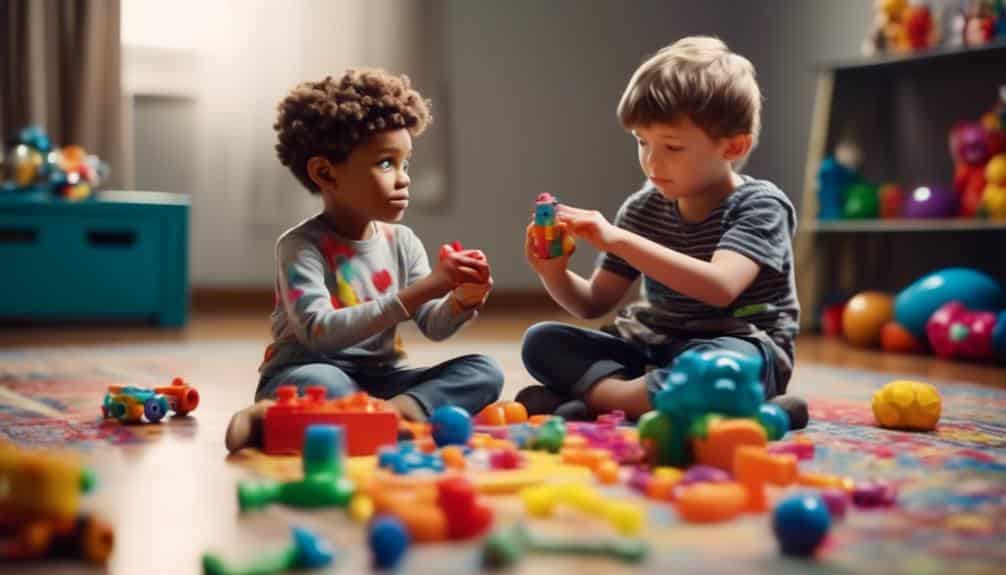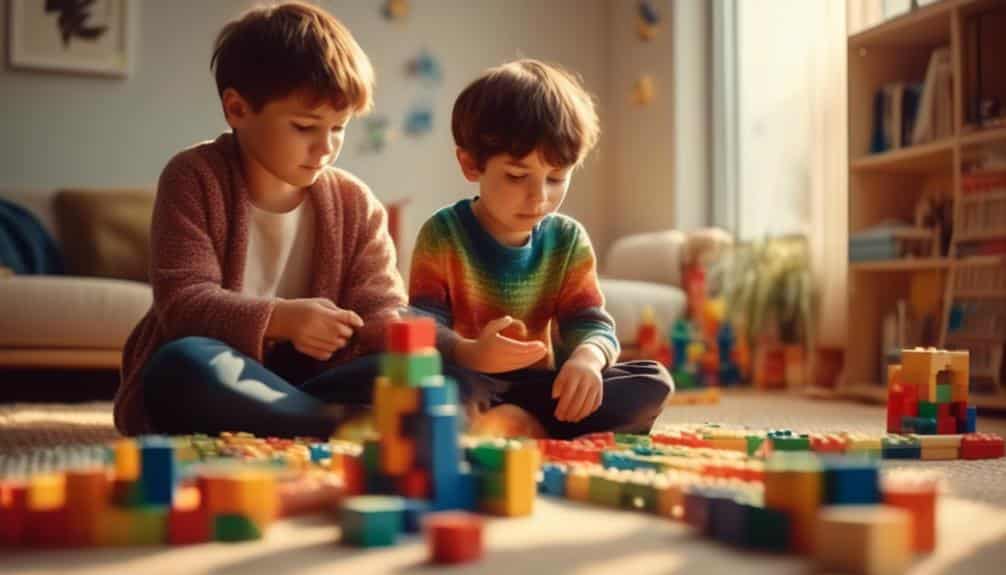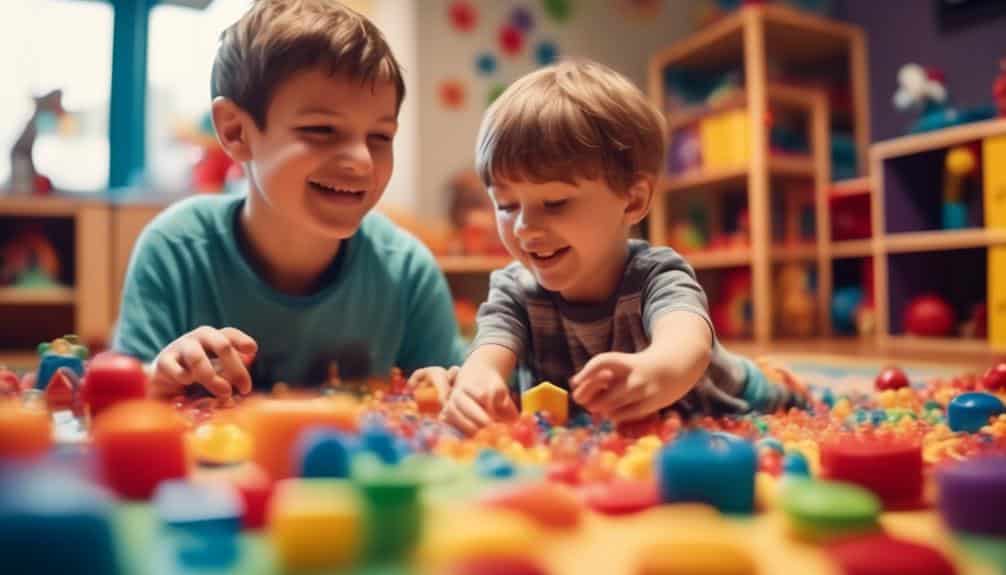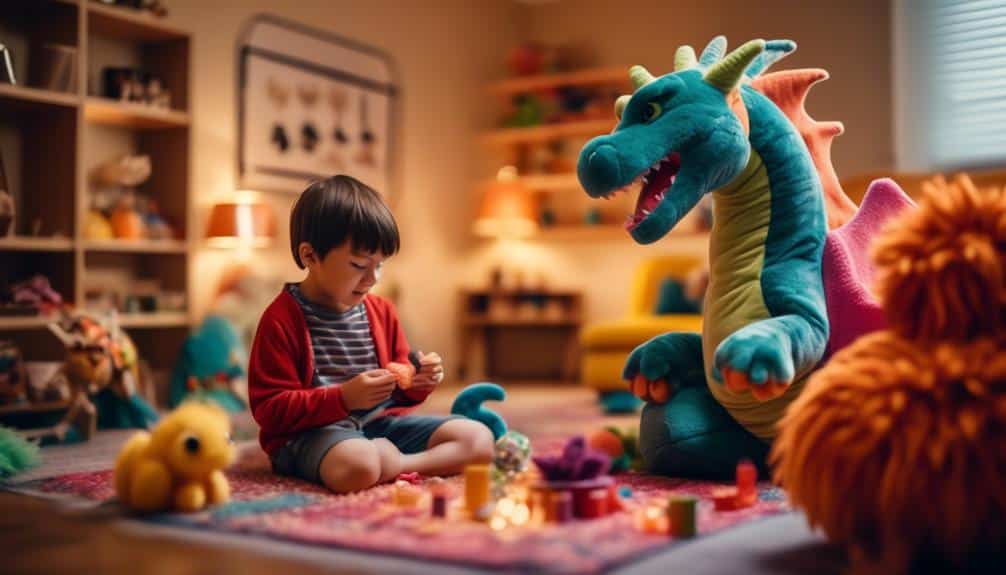The Developmental, Individual-difference, Relationship-based (DIR) model, commonly known as DIRFloortime, has emerged as a compelling and nuanced approach to supporting individuals with autism. Through its focus on fostering emotional and cognitive growth, DIRFloortime strategies for autism advocate for a tailored and empathetic method of engagement that aligns with each child’s unique rhythms and interests. Following the child’s lead and creating a calming environment are beneficial practices and foundational principles that set the stage for deeper connection and learning. The method’s emphasis on back-and-forth play and sensory activities underscores the importance of dynamic interaction and exploration in the developmental journey.
As professionals and caregivers alike seek to optimize the potential of this approach, one might ponder the implications of these strategies on long-term developmental outcomes and how they integrate with the child’s evolving capacities. To grasp the full scope of DIRFloortime’s impact, it is essential to consider the finer details of its application and the subtle yet profound ways it can influence a child’s engagement with the world.
Key Takeaways
- Floortime therapy is a relationship-based approach that recognizes the uniqueness of each child with autism.
- Fostering emotional connections and trust is crucial for meaningful social interaction.
- Tailoring strategies to the child’s strengths and interests enhances communication skills.
- Creating a calm, sensory-friendly environment and respecting the child’s lead supports sensory regulation.
Establishing Play Routines
Establishing play routines in DIRFloortime therapy is a fundamental step toward fostering meaningful interaction and communication for children with autism in a supportive and nurturing environment. Floortime, a relationship-based approach, centers on the uniqueness of each child with autism, recognizing the importance of their emotions and interests. Play therapy within Floortime is not a mere pastime; it’s a structured strategy to weave developmental goals into the fabric of enjoyable activities delicately.
The essence of Floortime is to meet children where they are, emotionally and developmentally, and to build upon their natural rhythms. By following the child’s lead in the play, therapists and parents can create a dynamic loop of interaction that is comforting and challenging for the child. This responsive approach ensures that the child’s interests lay the groundwork for engagement, enhancing the parent-child interaction.
Sessions, which can span from two to five hours a day, focus on back-and-forth play, essential for expanding the child’s circles of communication. The calm atmosphere is meticulously cultivated to encourage peer inclusion and support the child’s sensory, motor, emotional, cognitive, and communicative development, always respecting their pace and capabilities.
Fostering Emotional Connections

Fostering emotional connections through DIRFloortime involves recognizing and responding to a child’s emotional cues and nurturing a foundation for meaningful social interaction. Encouraging expressive interactions is essential, allowing children to feel understood and valued and promoting a sense of security and trust. Establishing trusting relationships within these engagements is paramount, as it supports the child’s willingness to explore and learn within a safe and responsive environment.
Recognizing Emotional Cues
Recognizing and appropriately responding to emotional cues is a crucial step in building solid and empathetic connections with children with autism. The DIR model emphasizes the importance of meeting a child at their developmental level and tailoring interactions to their unique social-emotional development needs. By recognizing emotional cues, parents and therapists can support a child’s emotional functioning and address developmental challenges with sensitivity and care.
- Observe the child’s nonverbal signals and vocal tones to gauge their emotional state.
- Respond to the child’s cues with empathetic communication and appropriate play activities.
- Employ strategies that encourage a child to express their emotions in a comfortable and safe environment.
- Support the child’s self-regulation by co-regulating emotions through modeling and guiding.
Encouraging Expressive Interactions
To cultivate a nurturing environment for children with autism, it is essential to encourage expressive interactions that promote their emotional and social development. By engaging in activities that foster these skills, we support the expansion of their communication abilities within the circles of communication. Expressive interactions are vital in cementing the bond in parent-child interactions, as they lay the groundwork for more meaningful connections.
| Strategy | Impact on Development |
|---|---|
| Open-ended Play | Enhances social engagement and emotional connections |
| Use of Gestures | Promotes growth in emotional and social skills |
| Safe Play Space | Adapts to individual preferences, encouraging the child |
| New Experiences | Supports cognitive development and problem-solving |
Setting aside specific times for Floortime sessions is crucial. These strategies represent developmental approaches that are informed, practical, and empathetic, designed to serve and uplift children with autism.
Building Trusting Relationships
Building trusting relationships in children with autism through DIRFloortime hinges on the foundation of engaging play that meets them at their level, thereby nurturing emotional connections essential for their social development. The Developmental Individual-difference Relationship-based (DIR) model, initially developed by Stanley Greenspan, emphasizes the critical role of these connections. Engaging in Floortime activities includes:
- They are participating in the child’s preferred activities to affirm their interests.
- Following the child’s lead in play to encourage a sense of security and trust.
- We are cultivating back-and-forth interactions to develop reciprocal communication.
- We involve family members to reinforce emotional bonds and consistency in the child’s environment.
These strategies build trusting relationships and foster a supportive atmosphere for the child’s social and emotional development.
Encouraging Joint Attention

Joint attention, a critical skill in child development, can be effectively nurtured through fun and engaging activities for children with autism. This foundational ability enables children with Autism Spectrum Disorder (ASD) to share experiences with others, paving the way for the growth of communication skills. By tailoring activities to the child’s developmental level, caregivers can help autistic children become more attuned to the social world around them.
Engaging in back-and-forth play that captures the child’s interest is beneficial to foster joint attention. Daily Floortime sessions offer the perfect opportunity for this interaction. As you follow the child’s lead, gently guide the play towards experiences, encouraging the child to look at, point to, or show objects of interest, thereby practicing joint attention.
Creating a reliable and soothing environment is paramount, allowing the child to feel secure and more open to engagement. Incorporating sensory toys that appeal to the child can also facilitate shared focus. Remember, the goal is to build upon each success, no matter how small, reinforcing the child’s efforts to connect. Through consistent, empathetic, and responsive interactions, joint attention skills can be meaningfully enhanced in children with ASD.
Enhancing Communication Skills

Having established the foundation of joint attention, we can now focus on strategies to further enhance communication skills in children with autism through the DIRFloortime approach. The DIRFloortime model emphasizes the importance of meeting children at their developmental stage and building upon their unique strengths and interests to promote growth in communication skills.
Implementing DIRFloortime at home or in therapeutic settings involves the following sophisticated actions:
- Engage in Play-Based Interactions: Tailor activities to the child’s interests to foster an environment where language skills can naturally emerge and flourish.
- Expand Circles of Communication: Encourage children to participate in shared activities with peers, which can improve social communication and offer a practical context for language use.
- Foster Inclusive Experiences: Include children with ASD in interactions with typically developing peers to provide diverse models of communication and socialization.
- Encourage Complex Communication: Provide opportunities for the child to engage in two-way communication, allowing them to initiate and respond during conversations during Floortime sessions.
These strategies are designed to support the child’s development respectfully and empathetically, recognizing that each child’s pathway to enhancing communication skills is unique and should be honored.
Supporting Sensory Regulation

Sensory regulation is a cornerstone for children with autism to engage comfortably in their surroundings, making it an essential focus in DIRFloortime therapy. A calm, sensory-friendly environment facilitates this regulation, allowing the child to focus on developmental growth without overwhelming sensory input. This nurtures a space where they can explore and relate to the world at their own pace.
In supporting the child’s sensory regulation, practitioners engage in back-and-forth play that respects and follows the child’s lead. This approach not only honors their Differences but also assists in modulating their sensory processing in a manner that feels safe and responsive to their needs. Sensory toys and activities are thoughtfully chosen to align with the child’s preferences, encouraging engagement and interaction during Floortime sessions.
Tailoring interventions to the child’s unique sensory profile is crucial. It enables the therapist to provide support that respects the child’s autism-related challenges and promotes emotional development. Therapists can gently expand the child’s comfort zone by encouraging open-ended play and introducing new experiences gradually. This strategy enhances sensory regulation, allowing the child to better navigate and thrive in their environment.
Expanding Interactive Play

Expanding Interactive Play within the DIRFloortime framework provides a scaffold for children with autism to build upon their communication skills through engaging, responsive interactions with others. This approach is designed not only to support the developmental capacities of autistic children but also to foster their innate curiosity and joy in play. Adults can facilitate a more interactive and dynamic learning environment by following the child’s lead and participating in their chosen activities.
Incorporating Expanding Interactive Play into a child’s routine involves several practices:
- Joining the child’s activities: Engage in play that the child is interested in to build rapport and encourage interaction.
- Following the child’s lead: Allow the child to guide the flow and direction of play, enhancing their sense of control and engagement.
- Encouraging two-way communication: Use activities to prompt the child to initiate communication and reciprocate, expanding their circles of communication.
- Creating a supportive environment: Ensure the space is conducive to play, minimize distractions, and provide a safe, inclusive setting for the child to explore and interact.
Through these strategies, floortime practitioners aim to enhance the interactive experiences of autistic children, thereby enriching their communication skills and emotional connections with others.
Following the Child’s Lead

Embracing the child’s interests, the DIRFloortime approach emphasizes following the child’s lead as a cornerstone of fostering robust social and emotional development. By joining the child in their chosen activities and interests, practitioners of Floortime create a therapeutic alliance that is respectful and supportive of the child’s unique perspective. This collaborative engagement is instrumental in enhancing communication skills, as it allows the child to navigate the realms of social interaction within a safe and familiar context.
The methodological inclusion of the child’s lead in Floortime sessions allows the child to naturally explore their environment and relationships. This sense of ownership and comfort is critical in encouraging the child to participate in meaningful back-and-forth play, essential for emotional and cognitive development.
Structured within calm environments, these tailored Floortime sessions—ranging from two to five hours a day—provide ample opportunities for children to expand their circles of communication. The ultimate goal is to nurture the child’s emotional and social connectivity capacity, addressing the developmental challenges children with autism may face. For individuals seeking autism tips, prioritizing the child’s lead within the DIRFloortime model is pivotal in cultivating warm, interactive relationships central to a child’s growth and engagement.
Creating Opportunities for Problem-Solving
Building on the foundation of following the child’s lead, the DIRFloortime approach also emphasizes the importance of creating opportunities for problem-solving to enhance the child’s developmental progress. Coming up with solutions bolsters the child’s cognitive skills and nurtures their communication abilities and emotional growth.
Utilizing the DIRFloortime model, practitioners and parents can adopt various strategies to encourage problem-solving:
- Engage in open-ended play, allowing the child to navigate and resolve challenges, fostering their ability to think critically and independently.
- Communicate using simple language, gestures, and facial expressions to support the child’s understanding and expression during problem-solving scenarios.
- Gradually introduce novel experiences to gently expand the child’s comfort zone, encouraging adaptability and resilience.
- Provide a variety of toys and activities that align with the child’s interests and developmental level, creating an inviting environment that promotes engagement and the application of problem-solving skills.
Through these methods, Floortime facilitates a supportive atmosphere where children with autism can practice problem-solving, ultimately aiding in their holistic development and preparing them for the complexities of daily life.
Incorporating Daily Activities

Integrating daily activities into DIRFloortime sessions allows children with autism to develop practical life skills within their natural routines, enhancing their engagement and fostering meaningful interactions. By incorporating daily activities, therapists and parents create a holistic approach to support a child’s development within their everyday environment.
Everyday routines such as mealtime, bath time, and playtime are ripe with opportunities for learning and growth. A parent might, for example, involve the child in setting the table, which can promote the development of daily living skills while encouraging social interaction and responsibility. The child learns a task during these activities, practices communication, and engages with others in a shared space.
Incorporating daily activities into the therapeutic process helps the child connect their learning to real-world contexts. This approach can be efficient as it aligns with the child’s interests and routines, making the learning process more natural and less intrusive. It also allows for developing problem-solving skills in a familiar setting, reducing stress and building confidence.
In essence, incorporating daily activities into DIRFloortime sessions can help the child develop critical competencies while nurturing their emotional and social growth in a manner that feels supportive and connected to their everyday life.
Building on Individual Differences
Recognizing and embracing the unique characteristics of each child with autism is essential in the DIRFloortime approach. We can create a supportive and effective learning environment by tailoring engagement methods to individual interests and abilities. This personalized approach fosters meaningful connections and encourages the growth of emotional, social, and cognitive skills in a way that honors the child’s individuality.
Embrace Unique Characteristics
Acknowledging and valuing the distinct characteristics of each child, DIRFloortime strategies emphasize the importance of customizing interventions to harness their strengths and interests. Every child is unique, and this approach helps children develop communication and adaptive skills aligned with their personal needs and preferences.
- Tailor therapy to the child’s developmental levels, focusing on their specific challenges and abilities.
- Engage in activities that reflect the child’s unique interests, promoting meaningful interaction.
- Adapt the environment and materials to meet the child’s sensory preferences, ensuring comfort and participation.
- Foster warm, responsive relationships vital for emotional and social growth within the Intervention program.
Tailor Personalized Engagement Methods
Building upon the foundation of embracing individual differences, Tailor Personalized Engagement Methods in DIRFloortime are designed to resonate with each child’s unique developmental journey, utilizing their innate interests as a gateway to foster deeper engagement and learning. Developed by Dr. Stanley Greenspan, this developmental model for children with Autism Spectrum Disorder (ASD) emphasizes the importance of personalized engagement. By aligning activities with each child’s passions, Floortime practitioners create an inviting space that encourages growth in communication skills and social-emotional capacities. It’s about meeting children where they are developmentally, offering a scaffold to higher levels of interaction. Such tailored strategies are crucial for nurturing the whole child, fostering meaningful emotional connections, and promoting the development of complex social engagement.
Engaging Through Pretend Play

Engaging children with autism through pretend play is a cornerstone of the DIRFloortime approach, fostering their creative and social development by immersing them in their world of imagination. Pretend play is an essential technique in Floortime to help children express themselves and build communication skills in a comfortable and natural setting. By engaging through pretend play, children are guided gently into enjoyable and educational interactions.
The following strategies are crucial when utilizing pretend play within the DIRFloortime framework:
- Enter their world: Begin by observing the child’s interests and joining in without directing the play. This builds trust and demonstrates acceptance.
- Follow their lead: Encourage the child to initiate interactions and dictate the flow of play, promoting their sense of control and agency.
- Expand the narrative: Introduce new elements or ideas to extend the play narratives, enhancing language use and cognitive flexibility.
- Embrace emotion: Use characters and scenarios to explore different emotions, providing a safe space for the child to express and understand feelings.
Incorporating these approaches can improve children’s ability to connect with others. Furthermore, when combined with speech therapy, pretend play can significantly enhance a child’s capacity to communicate effectively and meaningfully.
Frequently Asked Questions
What are the DIRFloortime Strategies for Autism?
The DIRFloortime approach for autism involves interactive play to foster emotional and social development, prioritizing the child’s interests to encourage communication and build upon their strengths within a nurturing and understanding environment.
What Is the DIR Method for Autism?
The DIR Method for autism, akin to a gardener nurturing diverse plants, focuses on fostering social, emotional, and cognitive growth through personalized, interactive play and relationship-building activities tailored to each child’s unique developmental stage.
What Is the Most Effective Intervention for Autism?
The most effective intervention for autism varies by individual needs but typically combines behavioral therapies, educational strategies, and family support to address communication, social skills, and behavioral challenges. Multidisciplinary approaches are often recommended.
How Do You Implement Dir Floortime?
To implement DIR Floortime, foster a nurturing environment where a child’s natural interests guide interactive play, ensuring engagement and developmental strides through consistent, empathetic, and adaptive sessions tailored to individual needs and milestones.
Conclusion
Autism spectrum disorders are a developmental disorder that affects the social interaction, communication, and behavior of children. DIRFloortime therapy is an intervention for children with autism that emphasizes the development of children’s emotional and intellectual capacities by challenging them to think logically and engage in back-and-forth communication. It is a practical approach for children with autism spectrum disorders, and many studies have shown that it can significantly improve emotional functioning and cognitive challenges.
DIRFloortime is a developmental approach to treatment developed by Stanley Greenspan, a renowned child psychiatrist and author in Developmental Psychology. The therapy involves a therapist working with a child and a parent to build warm, attuned parent-child relationships that create bridges between ideas and healthy peer relationships. It is also a guide for parents that teaches them to use Quick instructions and quick catchphrases to facilitate two-way communication, complex thinking, and creative thinking.
A systematic review and chart review of studies on DIRFloortime demonstrated its efficacy as an intervention for children with autism spectrum diagnoses. In a pilot study of preschool children with autism, a parent training intervention using DIRFloortime strategies improved critical cognitive and social-emotional capacities in children with autism. The approach has also been practical for adolescents with autism, as demonstrated by a Journal of Developmental and Behavioral Pediatrics study.
DIRFloortime therapy is a research-supported developmental approach focusing on the child’s profile and behavioral responses. It is a practical intervention approach shown to improve positive behavior and cognitive development in children with autism. The therapy focuses on developing crucial skills, such as emotional development, social interaction, creative thinking, and natural communication skills. It also helps to build complex interactions, such as affective interactions and creative arts therapy programs, which can help children develop healthy social relationships.


Recent Comments